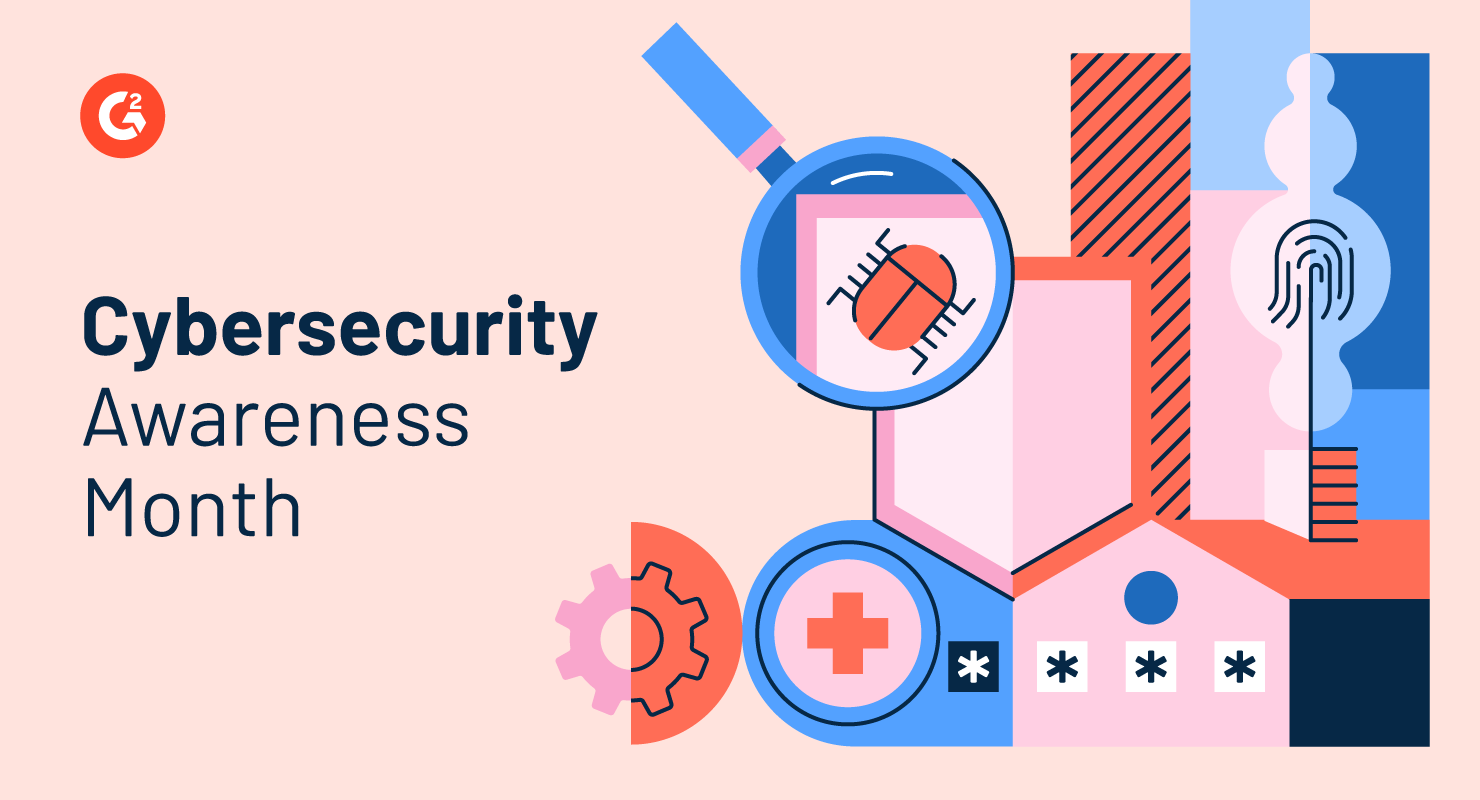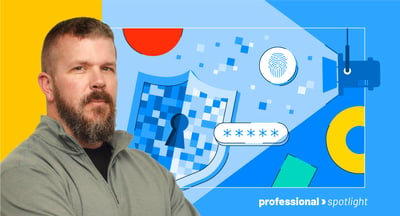October 28, 2024
 by Rachael Hill / October 28, 2024
by Rachael Hill / October 28, 2024

This Cybersecurity Awareness Month, G2 brings you a comprehensive look at the state of digital defense through the eyes of five key industry roles. In this exclusive blog post, we'll explore how different professionals approach cybersecurity challenges and their solutions.
By examining these diverse perspectives, we'll paint a complete picture of today's cybersecurity and data privacy landscape. From regulatory compliance to technical implementation and market trends to data protection strategies, we'll cover the full spectrum of digital security concerns.
Whether you're a C-suite executive, an IT professional, a compliance officer, or a curious tech enthusiast, you'll gain valuable insights to enhance your organization's security posture and privacy practices.
Join us as we unpack the multifaceted world of cybersecurity and data privacy, powered by G2's unparalleled software and solutions expertise from the perspective of five G2 subject matter experts!
My name is Lauren Worth, and I am a G2 market research analyst working primarily with our security and GRC categories.
Ransomware, which holds network access or data hostage until the target pays to have it released, has made a lot of headlines over the past couple of years. According to Sophos’ State of Ransomware 2024 report, 59% of 5,000 IT professionals surveyed reported being hit by an attack in the past year. While this number is lower than the previous two years, respondents noted that the attacks were more impactful.
Organizations are susceptible to ransomware attacks, in part because of the disruption they cause to business operations. The healthcare industry is extremely vulnerable to ransomware attacks because they not only interrupt operations but can also threaten to leak protected patient information if the target doesn’t pay. Data breaches of large hospital networks make the news, but smaller clinics and private practices are also vulnerable.
Bad actors can shut down networks that allow organizations to share patient information between hospitals, pharmacies, and insurance companies, causing staff to lose access to patient medical records. Withholding access to networks and patient data not only impacts operations and staff but the consequent delays in care endangers patient health. Bad actors know this and exploit it.
Risks to health-based organizations are substantial, yet few organizations invest in business continuity software. On G2.com, only 7% of reviews for products in the Business Continuity Management category come from users in healthcare or closely related industries. This figure does not include responses from reviewers in insurance and non-profit industries as we don’t have information on whether those respondents work in health-related organizations.
Organizations can reduce their vulnerability to ransomware attacks with robust business continuity plans. Business continuity software can help organizations maintain at least some operations, making them more resistant to threats from bad actors. By having the ability to mitigate the damage of a breach, organizations may be in a better position to resist ransomware demands or pay a smaller amount to recover compromised systems.
This type of software cannot protect healthcare organizations from penalties from HIPPA and other similar regulations once a leak has occurred, should demands include threats to release protected patient information. However, the savings from having a business continuity plan could alleviate some of the financial burden imposed on organizations that have protected patient information leaked as part of the attack.
Healthcare organizations should invest in business continuity management software and data recovery software or employ managed security service providers (MSSPs) with expertise in the healthcare industry.
It is critical that organizations of all sizes and industries have a robust business continuity plan and invest resources into software that can mitigate the potential damage of a ransomware attack. In cases like these, a good reactive plan is part of a well-rounded offensive strategy.
Tip: Check out any of the products in the Business Continuity Management software category page. Users’ top industries are included in each product summary on the category page. You can also filter by industry for reviews on each product page.
Your organization cannot hope you won’t face a ransomware attack or any other type of breach. Do what you can to minimize the risk of an attack, but assume you will be exposed and ensure you have a recovery plan before it’s too late.
My name is Rachael Hill, and I’m G2's governance, risk, and compliance (GRC) analyst. I love long walks with my dog, Pepper, a good scary movie (especially ones that are so bad they’re good), and people who complete their security training on time.
As a GRC analyst at G2, I've observed that while security automation can significantly enhance an organization's security posture, it also introduces new risks, particularly around team burnout and the challenge of addressing increasingly sophisticated threats.
The key to successful implementation lies in striking the right balance between automation and human oversight. Overzealous automation can lead to alert fatigue, a false sense of security, and skill atrophy among team members. Conversely, well-managed automation can free up valuable time for analysts to focus on complex issues and strategic thinking.
To mitigate these risks, organizations should implement tiered alert systems, adopt a human-in-the-loop approach, and foster continuous learning and adaptation.
Tiered alerts help prevent burnout by categorizing issues based on severity, allowing automated handling of low-level alerts while preserving human attention for critical matters. A human-in-the-loop approach ensures that automation augments rather than replaces human decision-making, maintaining crucial oversight and preventing complacency. Continuous learning, through regular updates to automation rules and ongoing team training, keeps both systems and personnel adaptive to evolving threats.
When implementing these strategies, it's crucial to have the right tools at your disposal. Several top-rated solutions on the G2 Grid® can help address various aspects of security automation and risk management. Crowdstrike Falcon leads in Endpoint Protection and Detection, offering AI-powered threat response. Okta tops Identity and Access Management, while Coralogix leads in Security Information and Event Management with powerful analytics. Tenable.io excels in Vulnerability Management, and Hoxhunt in Security Awareness Training!
For Cybersecurity Awareness Month, here's a fun tip: Turn cybersecurity into a team sport! Create friendly competitions for spotting phishing emails, reward individuals who finish their security training quickly, or host a "hack-a-thon" where employees try to find vulnerabilities in a safe, controlled environment. Remember, a security-aware team is a strong team, and who says it can't be fun, too?
My name is Brandon Summers-Miller, and I’m G2’s senior cybersecurity and data privacy research analyst. I help maintain the integrity and accuracy of our security and privacy categories on G2 and work with vendors to learn more about how these dynamic areas of technology are rapidly changing.
The threat landscape continues to evolve at unprecedented speed as new and innovative forms of technology emerge. While useful for cybersecurity efforts, bad actors are also quick to leverage these technologies for their own interests. Organizations must remain vigilant and safeguard their assets and data through diverse security protocols, including new identity and access management (IAM) mechanisms within the entire work environment.
Traditionally, identity provisioning as related to access management has been designated only for the identities of employees within an organization. Attackers have gradually learned how to exploit weaknesses in employee identity provisioning infrastructures, including password-dependent protocols, provisioning misconfigurations, and excessive permission abuse. Successful attacks that use these weaknesses, among others, have necessitated the specialization and increased comprehensiveness of identity provisioning and management.
Now, IAM solutions are broadening their scope to include identity provisioning beyond workers themselves. In addition to provisioning the workforce’s unique employee identities, a newer form of IAM now includes provisioning workloads themselves.
Workload identity and access management (WIAM) is more clearly defined as an identity provisioning practice in which specifically identified workloads — which, in other words, are applications, workflows, or other comprehensive digital resources — are only approved to access and interact with the specific sets of information they need to complete their predefined processes. This, for example, might include provisioning an organization’s calendar tool of choice to only be permitted to source data from the organization’s approved email provider and access the approved teleconferencing software.
IAM solutions already have a strong track record for added security and smart investment. According to G2 data provided by IAM software buyers, those who left responses reported to have achieved ROI within two years. It wasn’t just a slim majority either; more than 90% of respondents indicated as such. Even more impressive is that more than 70% of buyers indicated that their ROI with IAM products was within a year.
The fact that security IAM products already add to an organization’s cyber defenses is clear, and the developments within this area of already successful technology are promising. Adding further identity provisioning to devices beyond just the identities of the workforce adds another tight-knit layer of powerful security measures that make it that much harder for malicious actors to exploit already known vulnerabilities within traditionally defined IAM software. The combination of the two is sure to strengthen security programs at a time when increasingly sophisticated threats abound.
G2’s Identity and Access Management (IAM) software category is the place to find IAM software that will work best for any organization’s particular needs. While all of these products are designed to provision workforce identities, some of these products are already beginning to implement workload provisioning as well. Reviews can be filtered by company size, as well as which industries reviewers work in.
Cybersecurity is often approached with fearful attitudes and spoken of in negative language. This approach, I believe, does a disservice to the work that needs to be done to protect essential data. Take a proactive approach, gamify security habits, and take meaningful steps to educate employees about risks and best practices — especially when introducing new security and privacy measures.
My name is Ben Miljkovic, and I am a security engineer at G2.
As the Internet of Things (IoT) continues to revolutionize industries, homes, and our daily lives, it also presents a significant and often overlooked security risk. With billions of IoT devices connected worldwide, from smart thermostats and wearables to industrial sensors and wireless cameras, these connected technologies offer immense convenience. However, they also expose users and businesses to a broad range of vulnerabilities that cybercriminals are eager to exploit.
IoT devices are inherently vulnerable due to several factors:
The infamous Mirai botnet attack in 2016 is one of the most notable examples of how unsecured IoT devices can be weaponized. Hackers took advantage of weak default credentials to compromise IoT devices, turning them into a massive botnet that launched one of the largest distributed denial-of-service (DDoS) attacks in history. This incident highlighted the dangerous potential of IoT vulnerabilities when left unaddressed.
To mitigate IoT risks, both consumers and businesses must adopt proactive security measures:
Cybersecurity Awareness Month is a reminder that as we embrace the future of connected technology, we must also prioritize safeguarding it from potential threats. The convenience of IoT should not come at the cost of our security.
My name is Allie Navari, and I am G2's privacy manager. My team is responsible for ensuring G2 protects personal data and complies with global privacy laws and regulations. Within cybersecurity, we assist in identifying sensitive data, implementing appropriate safeguards, and ensuring security measures align with privacy requirements. This all plays a crucial role in building trust with our customers and mitigating risks associated with data breaches.
In today's interconnected world, personal information constantly flows through digital channels. From social media posts to online shopping transactions, our data is continuously being collected, stored, and often shared, making data privacy more crucial than ever.
Data privacy refers to the right of individuals to control how their personal information is collected and used. In the digital age, this information can include everything from your name and address to your browsing history and biometric data. Protecting this data is essential to prevent identity theft, financial fraud, and other forms of cyber crime.
Common threats to personal data online include hacking, phishing attacks, and data breaches. Cyber criminals are constantly developing new tactics to access and exploit personal information. However, by adopting best practices, individuals can significantly reduce their risk.
Some key strategies for protecting your information include:
It's also important to stay informed about privacy laws and regulations, such as the General Data Protection Regulation (GDPR) in Europe or the California Consumer Privacy Act (CCPA) in the United States. These laws give individuals more control over their personal data and require companies to be more transparent about their data practices.
Tip: Implement and enforce a robust password policy, including multi-factor authentication!
Quick action is crucial in the event of a data breach. This includes changing passwords, monitoring accounts for suspicious activity, and potentially freezing credit reports.
Remember, in the digital age, your personal information is one of your most valuable assets. By staying informed and proactive about data privacy, you can better protect yourself in our increasingly digital world.
Some popular privacy solutions I personally use within my job include:
Cybersecurity and data privacy are not one-size-fits-all situations! They truly demand unique approaches from everyone involved. Our G2 experts highlighted the need for constant attention and care, whether it's ensuring regulatory compliance, implementing cutting-edge technology, or staying ahead of market trends.
These perspectives share a mission — to strengthen cybersecurity and data protection across industries, roles, and organizations.
So don’t take the risk: use these expert insights and G2’s extensive cybersecurity resources to build a more secure, privacy-conscious future for your organization.
Rachael Hill is a Governance, Risk, and Compliance (GRC) Analyst at G2. Rachael loves long walks with her dog, Pepper, a good scary movie (especially ones that are so bad they’re good), and people who complete their security training on time.
In a digital world, where every click, swipe, and keystroke opens doors to endless...
 by Alexandra Vazquez
by Alexandra Vazquez
The zero-sum game between cyber adversaries and defenders is now becoming lopsided.
 by Jasmine Kharbanda
by Jasmine Kharbanda
In a digital world, where every click, swipe, and keystroke opens doors to endless...
 by Alexandra Vazquez
by Alexandra Vazquez
The zero-sum game between cyber adversaries and defenders is now becoming lopsided.
 by Jasmine Kharbanda
by Jasmine Kharbanda



